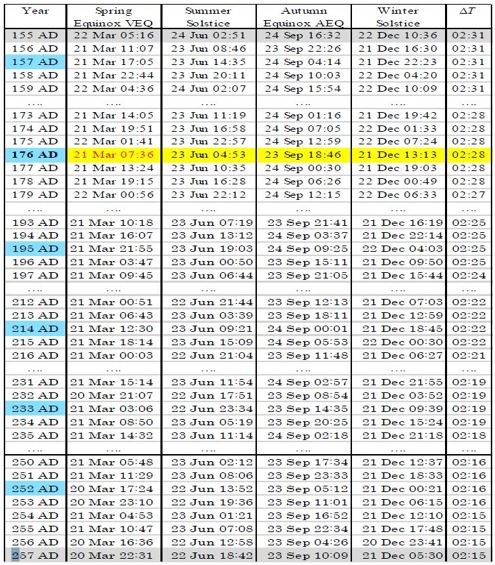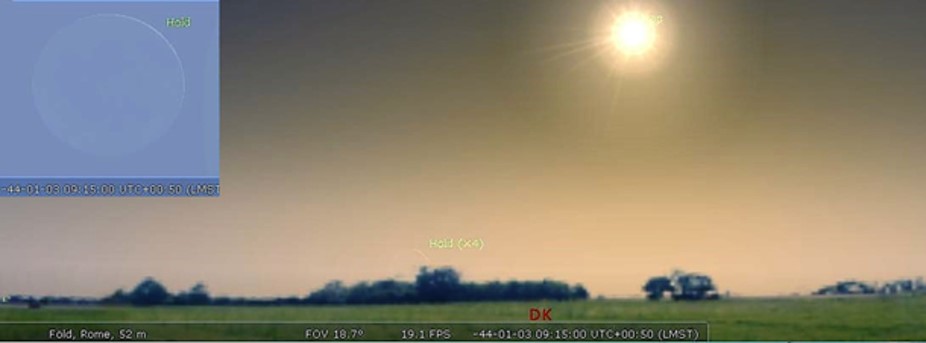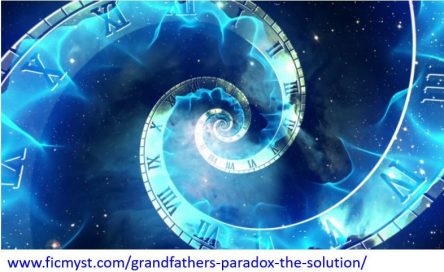
Eureka! Exclaimed Archimedes confidently. At least according to legend.
Eureka? I ask myself doubtfully. Doubtfully, because only a few “small signs” indicated until now that it might have been as it seemed based on the historical paradox mentioned earlier.
The first meaningful “astronomical and calendrical sign” of the 220-years time-shifting flashes up in this chapter.
Let us summarise first our recognition of Caesar’s calendar reform in the previous blogs:
The “Gregorian dilemma” can be explained only by contradictory assumptions and calendar calculations
– if we accept any of the VEQ dates previously assumed to be for 4BC (22, 23, 24 and 25 March), and
– if we accept any of the current theories concerning the initial misapplication of leap years.
According to some ancient records, later reminiscences, and indirect references to antiquity, in the first year of Julius Caesar’s new calendar:
– there was a new moon visible to the naked eye from Rome on 1 January and
– the VEQ day fell on 21 March.
However, these astronomical phenomena did not occur in the year 45BC.
The new moon crescent was only observable in 53BC, 34BC, 15BC, AD5, AD24, AD43, AD62 (etc., after the 19-year Metonic cycle) on January 1 in Rome.
The most plausible assumptions are (both from the point of view of Roman tradition and astronomy) that the Julian calendar began with a visible new moon on 1 January and that the vernal equinox (VEQ) fell on 21 March in the year the Julian calendar was introduced!
Let’s accept these two dates as a working hypothesis for further investigation!
If the year of a historical event can be associated with more than one astronomical phenomenon, we are in a favourable position to determine the accurate astronomical time.
The calendar reform of Julius Caesar is just such a remarkable historical event!
It is reasonable to assume (based on what we have seen so far) that the calendar problem surrounding the Gregorian dilemma is not due to the uncertainty of the VEQ date in March 45BC!
It is also possible that even the 45BC start year of Caesar’s calendar is wrong!
So, we should look for another start year of the Julian calendar in which occurred both: - a visible new crescent moon in Rome on 1 January, and - the date of the VEQ fell on 21 March.
Today we know that the VEQ in the Julian calendar fell predominantly (i.e., in three or four out of four years) on 21 March only between AD156 and AD256. (In preparation for later chapters, it should be noted here that the autumnal equinox (AEQ) fell on 23 and 24 September alternately every two years from 184 AD onwards. In addition, the autumnal equinox fell predominantly on 23 September for 100 years from AD216. This “alignment” of the dates of VEQ and AEQ is an inherent feature of the Julian calendar).
The original year of Caesar’s calendar reform must be in the period 156 to 256 AD because it occurred not until this century that VEQ day fell predominantly on 21 March.
So, we first must find out in which years (between AD156 and AD256) there was a new moon on January 1 that could be observed with the naked eye. (There were no telescopes yet).
See Table 2. for that period:

In the period from AD156 to AD256, there are six such years.
These are AD157, AD176, AD195, AD214, AD233 and AD252.
Because of the Metonic cycle, these years naturally follow each other every 19 years.
The year distance of these years from 45BC is respectively:
201, 220, 239, 258, 277 and 296 years.
We know from our earlier examinations that the length of the insertable period must be devisable by four and must be smaller than 249. Consequently, only 220 years is an acceptable assumption for the inserted period. Of the possible years, the only remaining is AD176 as the new year for Caesar’s calendar reform.
The astronomical parameters expected for BC45 met only 220 years later, in AD176. Therefore, raise the theoretical possibility that exactly 220 historical years were inserted into the AD time. Our time reckoning could have been 220 years prolonged!? Two hundred twenty years of error could have "slipped" into our chronology and history!?
Have a look at the still only just observable new moonrise on 3 January BC45:

In contrast, in AD176, a slightly more visible rising new moon crescent appeared in Rome as early as 1 January at 8:55 am.

Experts have not yet determined whether the first year of the Julian calendar was a leap year or not. Of course, I can’t decide that either. However, if the first year of the Julian calendar was AD176, as the current hypothesis suggests, then AD176 was probably not a leap year. If February in AD176 only 28 days was, then 1 January actually fell on today’s 2 January (as counted back now). In this case, the new moon was even more clearly visible in the sky on the first Kalendae of the new Julian calendar, as shown in the picture below.

Let us compare the currently accepted data with the new data we propose.
Summary of “EUREKA”; astronomical data of Caesar’s calendar reform:
Data accepted today: Astronomical New Moon: 2 Jan BC45, LT Rome 1:56, 0% brightness, undetectable On 1 January BC45 unbright, also undetectable. New moon rise on 3 Jan BC45; LT Rome 9:15, 1.8% brightness, difficult to detect VEQ in Rome: 23 March BC45; LT Rome 4:23
New data according to the present hypothesis: Astronomical new moon: 30 December AD175, 23:46 0% brightness, undetectable, On 31 December AD175, 0% brightness, also undetectable. New moon rise on 1 January AD176; LT Rome 08:55, 2.2% brightness, reasonably detectable and New moon rise on 2 January AD176; LT Rome 09:40, 6.7% brightness, very well detectable VEQ in Rome: 21 March AD176; LT Rome 11:04
It can be concluded that both the new moon on January 1 and the vernal equinox on March 21 is much more in line with the astronomically expected values of Caesar’s calendar reform and the data from the recollections in AD176 than 220 years earlier in the year BC45.
“A single measurement is not a measurement”, goes the engineering wisdom.
At any time, our measuring instruments may fail.
It helps approach any measurement from several angles, but it is equally important to check whether the measured value is possible at all. And if it is possible, whether is it realistic.
Based on our astronomical “measurements”, we now have a 220-year backwards shift in our current history. We have found that the year of Caesar’s Calendar reform had been placed from AD176 to 45BC, and this sounds unlikely.
Therefore, we need to look at some other historical events to see if those events could also have shifted backwards in time 220 years?
However, before we start looking at the dates of selected historical events, it is worth analysing whether it is even astronomically possible to insert 220 years?
Let us examine it accordingly, whether there are further astronomical arguments for the possibility of inserting 220 years? Other plausible astronomical arguments despite the counterarguments outlined earlier by astronomers?
Let us make an astronomical digression to refute earlier counterarguments against the possibility of a time shift of 220 (200-300) years.
